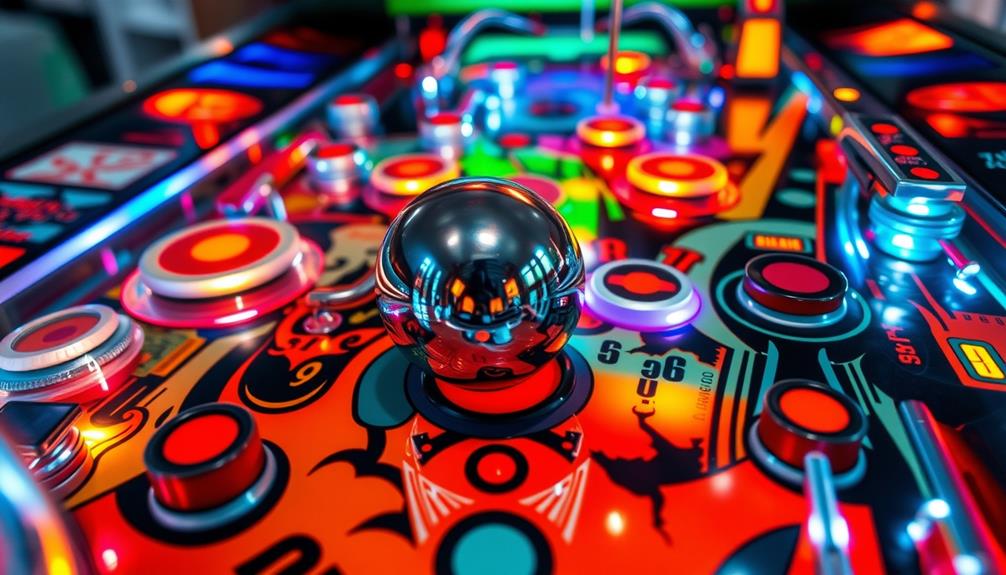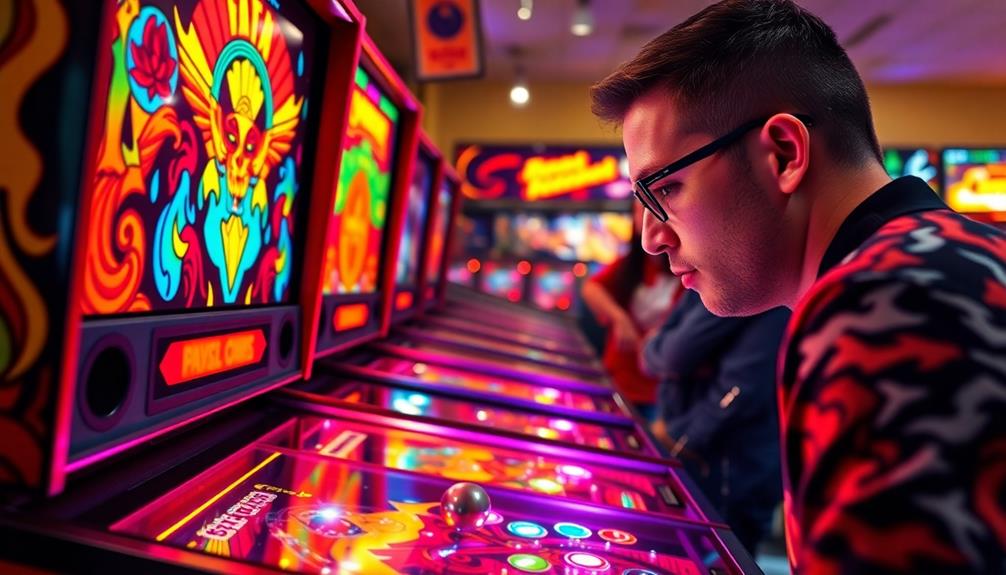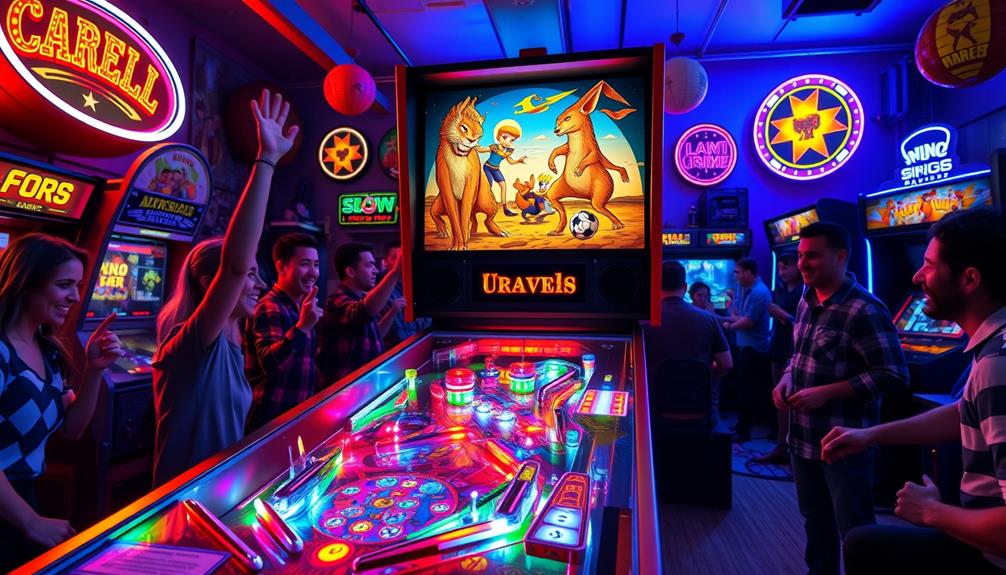A standard pinball measures about 1 1/16 inches in diameter and typically weighs around 80 grams. This size has been a mainstay in pinball machines for over 60 years, providing a consistent gameplay experience. However, there are variations like the 1-inch pinball used in Bally’s Truck Stop and the lighter Powerball featured in The Twilight Zone. These different sizes can impact gameplay dynamics and strategies. Custom pinballs are also an option, offering unique designs and materials. Understanding these factors can increase your enjoyment of the game. There is a lot more to discover in the fascinating world of pinball.
Key Takeaways
- The standard pinball diameter is 1 1/16 inches (2.7 cm) and has remained consistent for over 60 years.
- A standard pinball typically weighs around 80 grams, impacting gameplay speed and scoring potential.
- Variations exist, such as Bally's Truck Stop using a smaller 1-inch diameter pinball.
- Specialty pinballs, like the Powerball from The Twilight Zone, weigh 65 grams but maintain the standard diameter.
- Custom pinballs can vary in size, materials, and designs, enhancing visual appeal and gameplay dynamics.
Standard Pinball Dimensions
When it comes to the captivating world of pinball, understanding the standard dimensions of a pinball is vital for both enthusiasts and designers. The standard pinball has a diameter of 1 1/16 inches (2.7 cm) and weighs approximately 80 grams. This design has remained a cornerstone in the industry for over 60 years, ensuring a consistent gameplay experience across various pinball machines. For enthusiasts, knowing the standard dimensions of a pinball is essential for understanding the physics and mechanics of the game. Designers, on the other hand, rely on these dimensions to create the best possible playing experience for their machines. This consistency in size and weight allows for a smooth, predictable gameplay that can be enjoyed at the best pinball arcades around the world.
Curiously, just as juice diets may lead to nutrient deficiencies if not balanced, variations in pinball size can affect gameplay dynamics and strategies. You might be surprised to learn that while most pinballs share these standard pinball dimensions, some variations exist. For instance, Bally's Truck Stop (1988) utilized a 1-inch diameter pinball to avoid redesigning ramps. Additionally, specialty pinballs, like the Powerball from Twilight Zone, are lighter, weighing about 65 grams and made from ceramic.
If you're looking for something unique, custom pinballs are available in various designs and materials, including gold, silver, and black. These options can enhance your gameplay experience and add a personal touch to your pinball machine.
Understanding these standard dimensions helps you appreciate the equipment and improves your strategy when you play. So, whether you're a player or a designer, knowing these details is vital.
Variations in Pinball Size

When it comes to pinball, you'll find that not all balls are created equal. While standard pinballs typically measure 1 1/16 inch in diameter, variations like the 1-inch balls used in Bally's Truck Stop or the lighter Powerball from The Twilight Zone offer unique gameplay experiences.
Understanding the common financial terms can also enhance your approach to investing in pinball machines.
Plus, custom pinballs come in various designs and colors, adding a personal touch to your game.
Standard Pinball Dimensions
Although most pinball machines have standardized around a pinball diameter of 1 1/16 inches (2.7 cm) and a weight of approximately 80 grams, variations do exist that cater to specific gameplay needs. These standard pinball dimensions have been in place for over 60 years, ensuring a consistent experience across many machines.
Understanding the mechanics of different brewing methods can enhance not only your coffee experience but also your grasp of how varied designs can impact gameplay in pinball.
However, certain games break this mold. For instance, Bally's Truck Stop (1988) uses a smaller 1-inch diameter pinball to fit unique ramp designs, altering the gameplay experience.
Sega's Viper Night Driving featured Glo-Balls, coated in yellow rubber and weighing 60 grams, but they were less popular due to their feel and durability.
Another notable variant is the Powerball introduced in The Twilight Zone pinball machine, which weighs 65 grams and is made of ceramic. This lighter ball adds a different dynamic to the gameplay, challenging players in new ways.
Custom pinballs also exist, offering various designs and materials, such as gold and silver, enhancing both aesthetics and gameplay.
While the standard pinball dimensions are widely accepted, these variations show how creativity can impact play styles and experiences in pinball machines.
Specialty Ball Variations
Specialty ball variations shake up the traditional pinball experience by introducing unique sizes and materials tailored to specific gameplay needs.
These specialty balls can greatly alter how you play and interact with the machine, offering distinct challenges and aesthetics. For instance, astrology claims to influence personality traits and attractiveness in various ways, just as different pinball designs can enhance the gaming experience.
Here are four notable examples:
- Bally's Truck Stop (1988): Featured a 1-inch diameter ball, allowing for precise design without compromising ramp structures.
- Sega's Viper Night Driving: Introduced Glo-Balls, coated in yellow rubber and weighing 60 grams. Though unique, their feel made them less popular among players.
- The Twilight Zone: Brought forth the lighter Powerball, a ceramic ball weighing 65 grams, enhancing gameplay dynamics and strategy.
- Atari's Hercules: Utilized a ball designed with unique dimensions, resembling a real pool ball, providing distinct gameplay effects.
Custom pinballs can also come in various colors and designs, like black pinballs from Back Alley Creations, adding an aesthetic twist to standard steel balls.
Embracing these specialty balls not only diversifies your gaming experience but also invites you to explore the intricacies of pinball design.
Custom Pinball Options
Exploring custom pinball options opens up a world of unique sizes and designs that can enhance your gaming experience. Custom pinballs come in a variety of weights and styles, adding depth to gameplay and aesthetics. For instance, lighter options like the Powerball weigh just 65 grams, while standard pinballs are typically 80 grams. Some games, such as Bally's Truck Stop (1988), even feature a unique 1-inch diameter pinball to fit specific design needs.
Here's a look at some exciting custom pinball options:
| Type | Description |
|---|---|
| Gold Pinballs | Luxurious designs that enhance visual appeal |
| Light Ball | Unique effects used in games like Pinball Magic |
| Black Pinballs | Custom options available from Back Alley Creations |
| Specialty Pinballs | Variations that cater to collectors and enthusiasts |
These customizations not only alter gameplay but also make each pinball machine a unique piece, often becoming part of the backbox design. With rights reserved to the manufacturers, the possibilities for custom pinballs are virtually endless!
Materials Used for Pinballs
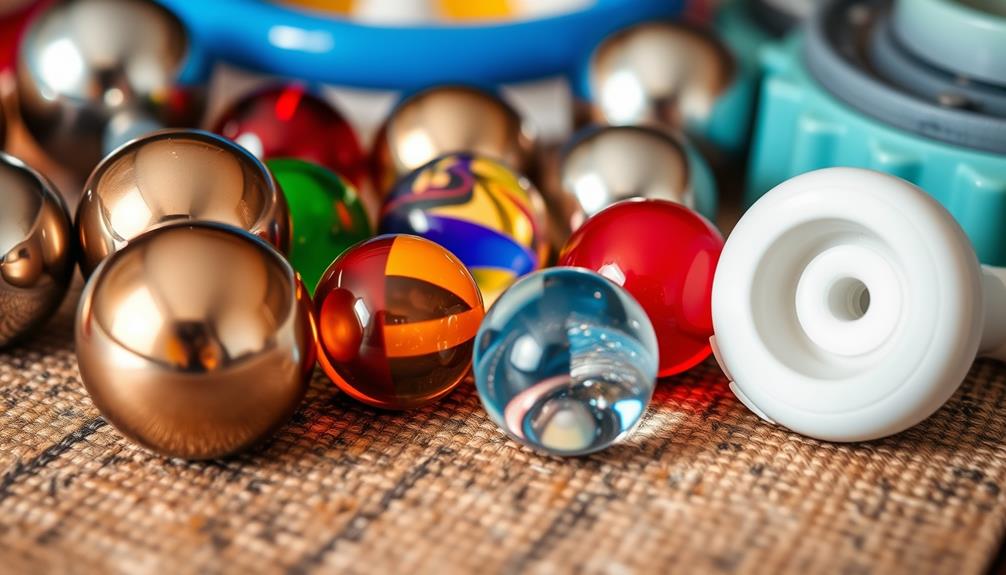
When it comes to pinballs, the materials used can really affect your gameplay experience. The choice of materials not only influences durability but also impacts the ball's movement and interaction with the playfield.
You've got standard carbon steel for durability, but chrome steel offers a shinier, more magnetic alternative. Plus, custom pinballs come in various colors and finishes, adding a unique flair to the game.
Appliance maintenance can extend lifespan of your gaming experience by ensuring that the machines are kept in peak condition.
Types of Steel Used
Pinballs are primarily made from different types of steel, each offering unique benefits for gameplay. Understanding these materials can enhance your appreciation of the game and its mechanics, much like how essential oils for respiratory health can improve overall well-being.
Here are the main types of steel used:
- Carbon Steel: This is the most common material for pinballs. It provides a smooth, mirror-like finish and excellent durability, ensuring consistent performance during play.
- Chrome Steel: A harder option, chrome steel retains its shine longer than carbon steel. However, be cautious—it's more magnetic, which can affect how it interacts with components in the backbox folded.
- Specialty Materials: Some pinballs, like the lighter Powerball in Twilight Zone, use unique materials such as ceramic. These can change gameplay dynamics and offer a different feel.
- Custom Finishes: Though not a steel type per se, custom pinballs come in various finishes like gold, silver, and black. These designs not only boost aesthetics but can also enhance your experience at the top of the backbox.
Regular inspections and maintenance are vital, as the materials can wear down over time, affecting performance.
Custom Pinball Variations
Custom pinball variations offer players a chance to experience unique gameplay through different materials and designs. While standard pinballs measure 1 1/16 inches and weigh 80 grams, specialty options like the Powerball from Twilight Zone weigh only 65 grams due to their ceramic construction. This lighter material can create a different feel and speed during play.
Understanding the impact of materials is essential for creating a unique gameplay experience that caters to various player preferences.
You'll also find custom pinballs available in a plethora of colors and finishes, such as gold, silver, and black, enhancing the visual appeal while offering unique gameplay experiences. For instance, Atari's Hercules features a pinball made from an actual pool ball, highlighting the creativity in pinball design.
Most regular pinballs are crafted from carbon steel, providing a sleek, mirror-like finish. In contrast, chrome steel pinballs are harder and maintain their shine longer, though they can be more magnetic.
The choice of materials not only affects the aesthetics but also the dynamics of the game. Whether you prefer a traditional feel or want to experiment with innovative designs, custom pinball variations cater to every player's desire for a distinct gaming experience.
Maintenance of Pinball Size

To maintain the ideal performance of your pinball machine, regular maintenance of the pinball size is essential.
Standard pinballs, with a diameter of 1 1/16 inches (2.7 cm) and weighing around 80 grams, have been the norm for over 60 years.
Keeping these pinballs in top shape guarantees that your gameplay remains smooth and enjoyable, which is similar to the importance of proper diet for pets in maintaining their health.
Here are four maintenance tips to help you:
- Regular Inspections: Check your pinballs frequently for any signs of wear or scratches. If they start looking hazy, it's time to take action.
- Cleaning: Clean your pinballs regularly to maintain their shine and prevent scratches. A tumbler cleaning is an effective way to restore their luster.
- Replacement: Replace pinballs when scratches become too deep, as this can impact gameplay and the longevity of your machine.
- Monitor Playfield Conditions: If your playfield has fewer rubber rings and more metal components, inspect and replace pinballs more often, as they can wear down faster.
Special Pinball Types

When it comes to pinball machines, special pinball types can greatly enhance your gaming experience. One notable example is Bally's Truck Stop (1988), which utilized a unique 1-inch diameter pinball. This design allowed for innovative ramp setups without extensive modifications.
Additionally, many modern pinball machines incorporate unique ball designs to improve gameplay dynamics and player engagement, making them a popular choice among enthusiasts. Sega's Viper Night Driving introduced Glo-Balls, coated in yellow rubber and weighing 60 grams. While they offered distinct play effects, their feel and durability didn't resonate with many players.
The Twilight Zone pinball machine features the Powerball, a lighter ceramic ball weighing 65 grams. This specialty ball changes the gameplay dynamics, making it a unique challenge. Stern's Avatar LE also incorporates the white Powerball, adding another layer of variation to its gameplay mechanics.
If you're looking to personalize your experience, custom pinballs come in various designs and colors, including gold, silver, and black. These options let you express your style while playing.
Whether you're aiming for a unique feel or a visually striking look, special pinball types can considerably alter how you engage with the game, making each session memorable and exciting.
For those interested in enhancing their home experience, best vacuums for dust removal can be a great addition to your pinball setup!
Impact of Size on Gameplay
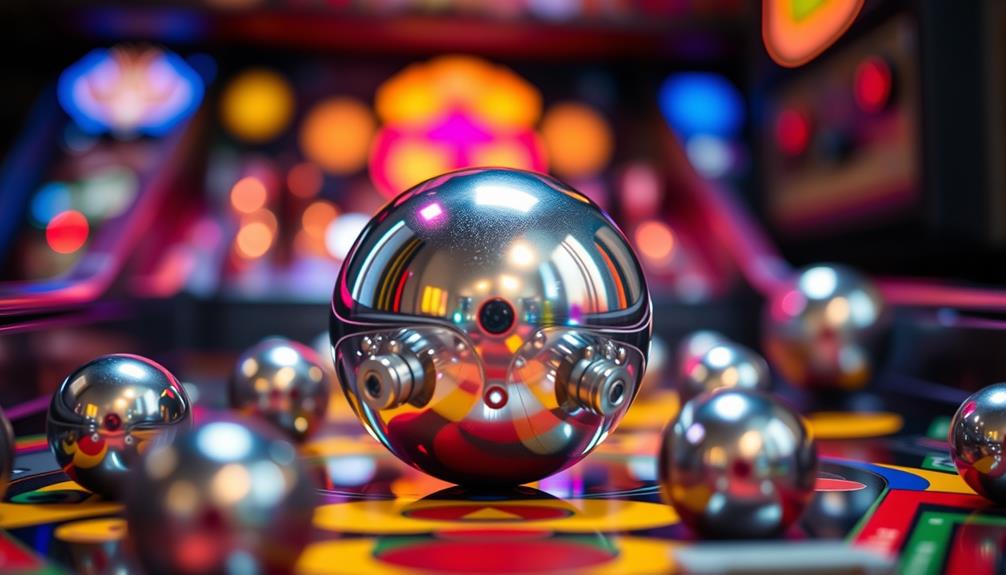
The size of a pinball directly influences gameplay dynamics and player strategy. When you play, the standard diameter of 1 1/16 inches (2.7 cm) guarantees a consistent experience across most machines. However, variations in size can lead to significant changes in how you approach the game.
Here are some key impacts of pinball size on gameplay:
- Game Mechanics: Smaller sizes, like the 1-inch pinball in Bally's Truck Stop, require you to adjust your strategy, especially with ramp designs. Understanding how piercing care and hygiene relate to maintenance can enhance your overall experience in various activities.
- Speed and Trajectory: The standard pinball weighs around 80 grams, affecting how quickly it moves and its scoring potential, which can change your tactics.
- Material Differences: Chrome steel or lighter materials like ceramic can alter magnetic properties, durability, and interaction with the flippers, affecting your gameplay experience.
- Specialty Balls: Unique balls, such as the Powerball in Twilight Zone, create distinctive gameplay dynamics that demand different strategies and interactions.
Understanding these factors can enhance your overall enjoyment and performance in pinball games.
Historical Size Changes
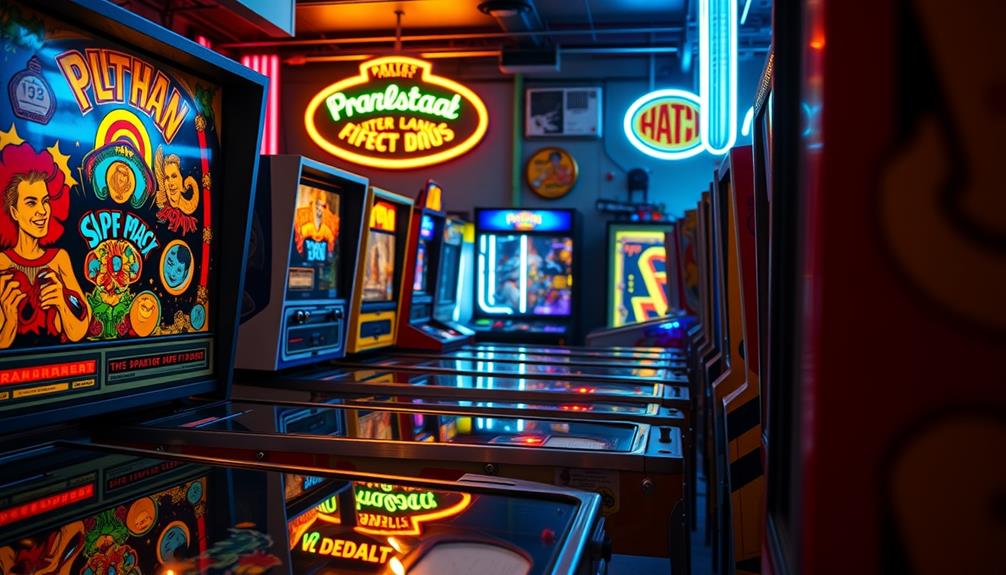
Over the decades, pinball size has evolved, reflecting both technological advancements and shifts in player preferences. For most machines over the last 60 years, the standard diameter has remained at 1 1/16 inches (2.7 cm), establishing a consistent benchmark for gameplay.
Water parks, like those found in many hotels, also adapt to changing trends and guest experiences, showcasing family-friendly amenities that attract visitors of all ages. However, notable deviations have occurred. In 1988, Bally's Truck Stop introduced a smaller, 1-inch diameter pinball, allowing for existing ramps to be used without redesign. This marked a significant change in pinball design.
Sega's Viper Night Driving took innovation a step further by incorporating Glo-Balls, which featured a unique yellow rubber coating and weighed 60 grams, diverging from the traditional steel balls. Similarly, The Twilight Zone pinball machine showcased the Powerball, a lighter ceramic ball weighing only 65 grams but maintaining the same diameter.
While most custom and specialty pinballs, including those crafted from gold, silver, and black materials, have retained the standard diameter, these variations highlight the creativity within the pinball industry.
As player preferences shift and technology advances, the evolution of pinball size continues to reflect a dynamic gaming landscape.
Community Insights on Pinball Size

Pinball enthusiasts often share their thoughts on how size impacts gameplay and player experience. The standard pinball diameter of 1 1/16 inches has been a staple for over 60 years, but variations have sparked interesting discussions within the community.
Here are some insights that highlight the importance of pinball size:
- Gameplay Dynamics: Many players note that smaller pinballs, like those used in Bally's Truck Stop, can change the game's flow, making it feel faster and more challenging.
- Aesthetic Appeal: Custom pinballs crafted from unique materials, such as gold or silver, not only enhance gameplay but also provide a stunning visual element.
- Durability Concerns: Glo-Balls, introduced by Sega, faced criticism for their feel and durability, reminding players that size isn't the only factor—quality matters too.
- Maintenance Importance: Regular inspections are essential. Scratched or hazy pinballs can lead to poor performance and damage to the playfield, emphasizing the need for care regardless of size.
These insights show that the size of a pinball can influence various aspects of the game, affecting both the experience and the community's appreciation for this classic pastime.
Frequently Asked Questions
What Are the Dimensions of a Folded Pinball?
You won't find dimensions for a folded pinball, since they don't exist. Pinballs are solid spheres, maintaining their shape during play. Their design and size have stayed consistent across most pinball machines for decades.
What Are the Sizes of Pinball Tables?
When you consider pinball tables, they usually measure around 51 inches long, 28.5 inches wide, and 75.5 inches tall. You'll need enough space between machines for proper access and enjoyment during gameplay.
How Much Space Do I Need for a Pinball Machine?
Setting up a pinball machine's like arranging furniture for a party; you need space for movement. Make sure at least 75 cm around it, and consider height adjustments to fit comfortably under your ceiling.
What Is Standard Pinball Glass Size?
When you're considering pinball glass, standard dimensions are 109.3 cm in length and 53.3 cm in width, with a thickness of less than 0.5 cm. Always opt for tempered glass for safety.
Conclusion
In the world of pinball, size isn't just a number; it's a reflection of the joy and nostalgia these machines bring. Whether you're drawn to the classic dimensions or the unique variations, each pinball has its own charm, creating a magical experience. As you play, remember that every flip and tilt is a journey through time, connecting you to the vibrant community that cherishes these beloved games. Embrace the size, and let the memories roll!


